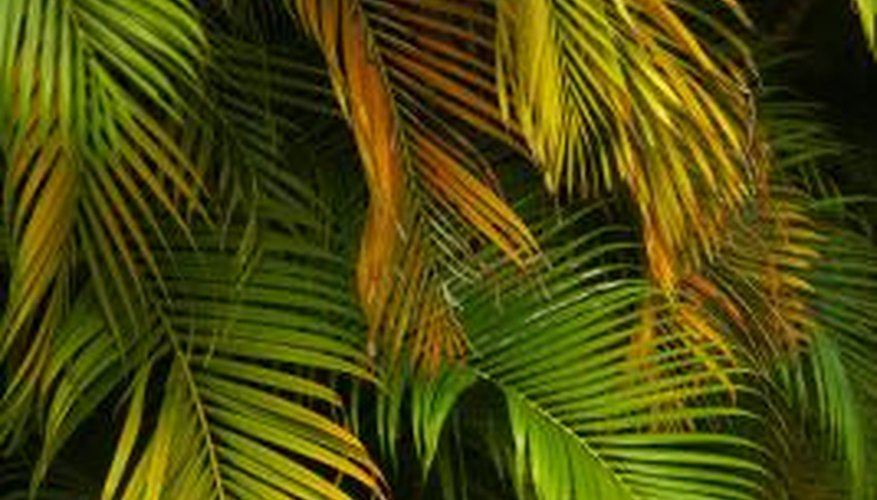Palms are susceptible to fungi attacks that often cause the plants to rot. Some disease causing organisms are very specific, infecting a specific palm with a particular disease. Other organisms produce different diseases on different palm trees. For instance Gliocladiium vermoeseni causes trunk canker on queen palms but canary island date palms develop a bud rot instead. In order to identify problems with your rotting palm, it may be necessary to know what type of palm it is.
Root Rots
Palms are susceptible to two different root rot fungi, including Phytophthora and Armillaria. Symptoms of Phytophthora include browning and death of young leaves, discolouration of the stem and a bad smell. Palms that are grown in poorly draining soil are especially prone to developing this fungus. Ensure trees have good drainage, and don't overwater them. Infected palms can be treated with fosetyl aluminium.
- Palms are susceptible to two different root rot fungi, including Phytophthora and Armillaria.
Symptoms of Armillaria root rot include leaves that are stunted, yellow or brown. Carefully peel the bark away from the wood on the lower trunk and trees, to reveal a white fungus growth underneath the bark. Honey-coloured mushrooms may also grow around the base of the tree. There is no cure for this disease. Remove and destroy all of the root system and the stump.
Pink Rot
Pink rot fungus is a rose or salmon-coloured fungus that usually infects older palm trees growing in coastal areas where it is humid. It causes spotting and rotting on all parts of the trees, especially the leaves. This fungus produces billions of spores on a single plant so there's no way to avoid it. However, it can only infect stressed palms, usually through wounds. Control pink rot by avoiding injuries to your palm tree. Applications of fungicides like Thiophanate-methyl can help prevent infections.
- Pink rot fungus is a rose or salmon-coloured fungus that usually infects older palm trees growing in coastal areas where it is humid.
- However, it can only infect stressed palms, usually through wounds.
Bud Rot
Phytophthora bud rot attacks several species of palm and can infect the roots, leaves, stems and fruit of trees. Symptoms include the appearance of brown sunken spots on developing fronds. The fronds turn a light greyish-brown and then darker brown as they collapse at the base. The infection spreads to the bud tissue and to the base of nearby fronds, which turn yellow and fall off the plant. As the disease advances, the buds die, and the decaying bud tissue has a bad smell. Phytophthora bud rot infects trees that are at least 2 years old, and often occurs a month or so after a heavy rain period. Occasionally, trees recover from this disease, but usually die within two years of infection. Trees with advanced symptoms should be removed and destroyed. Fungicides can be applied to healthy neighbouring palms, or to palms in the early stages of the disease.
- Phytophthora bud rot attacks several species of palm and can infect the roots, leaves, stems and fruit of trees.
- The infection spreads to the bud tissue and to the base of nearby fronds, which turn yellow and fall off the plant.
Butt Rot
Ganoderma butt rot causes the lower 4 to 5 feet of the trunk to rot. In addition, the palm can suffer from mild to severe wilting. A definitive diagnosis can be made with the appearance of a hard, shelf-like structure called a conk that attaches to the lower 4 to 5 feet of the trunk, but not all infected palms produce conks. Reasons why this disease develops aren't known and there are no ways to prevent or cure this infection. Remove infected palms as soon as conks appear, along with as much of the stump and root system as possible and do not plant any other palms in the same soil.
- Ganoderma butt rot causes the lower 4 to 5 feet of the trunk to rot.
- A definitive diagnosis can be made with the appearance of a hard, shelf-like structure called a conk that attaches to the lower 4 to 5 feet of the trunk, but not all infected palms produce conks.
